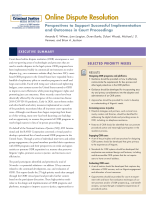Equipment and technology
Rapid detection and validated quantification of psychoactive compounds in complex plant matrices by direct analysis in real time-high resolution mass spectrometry - Application to "Kava" psychoactive pepper products
Justice Technology Information Center Annual Report 2019
Total RNA Analysis of Bacterial Community Structural and Functional Shifts Throughout Vertebrate Decomposition
Online Dispute Resolution: Perspectives to Support Successful Implementation and Outcomes in Court Proceedings
Recidivism Forecasting Challenge: Official Results
NIJ's Recidivism Forecasting Challenge aims to improve the ability to forecast recidivism using person- and place-based variables with the goal of improving outcomes for those serving a community supervision sentence. We are pleased to post official results below in Student, Small Team, Large Team, and Accounting...
A study of the mid-infrared emissivity of dried blood on fabrics
Mid-infrared emissivity of nylon, cotton, acrylic, and polyester fabrics as a function of moisture content
Vapor phase GC-IR identification of regioisomeric N-methoxybenzyl-4-substituted-2, 5-dimethoxyphenethylamines (NBOMe)
Innovative engineering and sensing strategies for aptamer-based small-molecule detection
Bayesian regression analysis of stutter in DNA mixtures
Notes From the Field: Using Forensic Intelligence to Drive Gun Crime Investigations
Contraband Detection Technology in Correctional Facilities An Overview of Technologies for Screening People, Vehicles, and Correctional Settings
The U.S. Criminal Justice System in the Pandemic Era and Beyond: Taking Stock of Efforts to Maintain Safety and Justice Through the COVID-19 Pandemic and Prepare for Future Challenges
Remote Methods for Volunteering Digital Evidence on Mobile Devices
Providing Reliable Interoperability for First Responders
The emergency communications ecosystem can be supported by planning in advance, developing relationships, and implementing new technology where appropriate.
Expanding Research to Examine the Impacts of Forensic Science on the Criminal Justice System
In 2004, the National Institute of Justice created the social science research on forensic sciences (SSRFS) research program to explore the impact of forensic sciences on the criminal justice system and the administration of justice. Much of the early research from the SSRFS program focused on DNA processing and the use of DNA in investigations and prosecutions.
See the YouTube Terms of Service and Google Privacy Policy



